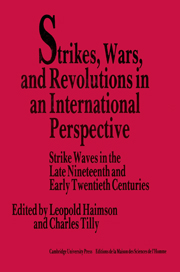 Strikes, Wars, and Revolutions in an International Perspective
Strikes, Wars, and Revolutions in an International Perspective Book contents
- Frontmatter
- Contents
- List of contributors
- Preface
- Part I Introductions
- Part II Models and realities
- 3 Introduction
- 4 Changing forms of labor conflict: secular development or strike waves?
- 5 Strikes and power in Britain, 1870–1920
- 6 Two strike waves in Imperial Russia, 1905–1907, 1912–1914
- 7 Strikers in revolution: Russia, 1917
- 8 Strikes in Imperial Russia, 1895–1913: a quantitative analysis
- 9 Labor conflicts in Italy before the rise of fascism, 1881–1923: a quantitative analysis
- 10 Strikes and politics in the United States, 1900–1919
- Part III Workers in metal-processing enterprises in comparative perspective
- Part IV The effects of short-term variation
- Part V Conclusion
3 - Introduction
Published online by Cambridge University Press: 25 March 2010
- Frontmatter
- Contents
- List of contributors
- Preface
- Part I Introductions
- Part II Models and realities
- 3 Introduction
- 4 Changing forms of labor conflict: secular development or strike waves?
- 5 Strikes and power in Britain, 1870–1920
- 6 Two strike waves in Imperial Russia, 1905–1907, 1912–1914
- 7 Strikers in revolution: Russia, 1917
- 8 Strikes in Imperial Russia, 1895–1913: a quantitative analysis
- 9 Labor conflicts in Italy before the rise of fascism, 1881–1923: a quantitative analysis
- 10 Strikes and politics in the United States, 1900–1919
- Part III Workers in metal-processing enterprises in comparative perspective
- Part IV The effects of short-term variation
- Part V Conclusion
Summary
A wide range of contributions reflecting a variety of concerns appear in this section: descriptive studies that examine the strike waves that broke out in various European countries on the eve, during, and in the immediate aftermath of the First World War, and compare them with earlier strike waves in these countries' labor histories; more theoretical treatments that scrutinize these strike waves in the perspective of the overall evolution of patterns of labor unrest in the countries under their scrutiny in the second half of the nineteenth and in the early twentieth centuries, and assess the adequacy of the models that have been applied to analyze their dynamics; and a number of quantitative studies that seek in a variety of ways to test the statistical validity of these and other approaches in accounting for the scope, intensity, and character that certain of these strike waves assumed, especially after the turn of the century. Yet, however implicitly in some cases, all of these contributions have had to confront, and challenge at least to some degree, the adequacy – at least in accounting for the phenomenon of strike waves – of two major theoretical models that have dominated the analysis of industrial labor conflits, especially in quantitative studies.
The first of these models, largely developed by economists and economic historians, has focused attention on the relationships between patterns of labor unrest and short-term as well as long-term cycles in economic and particularly industrial development.
- Type
- Chapter
- Information
- Strikes, Wars, and Revolutions in an International PerspectiveStrike Waves in the Late Nineteenth and Early Twentieth Centuries, pp. 35 - 46Publisher: Cambridge University PressPrint publication year: 1989
